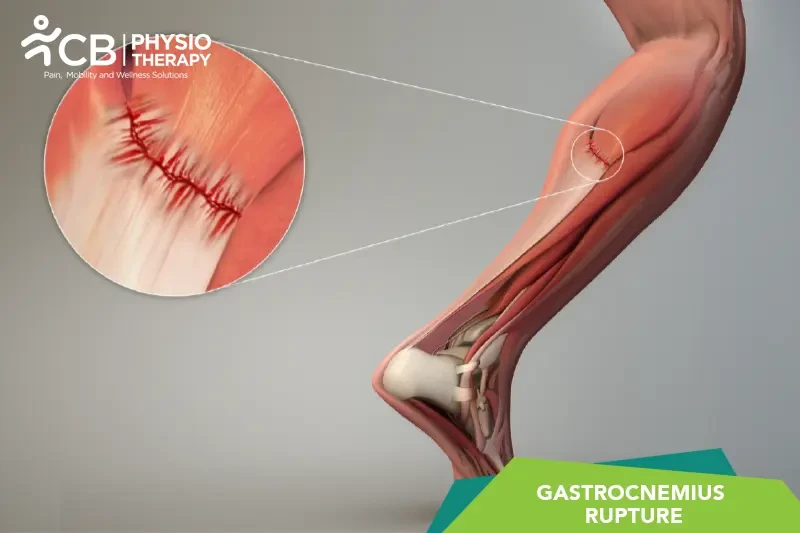Rest: Avoid activities that stress the calf muscle. Crutches may be used to prevent putting weight on the injured leg.
Cryotherapy: Cryotherapy (ice packs) is applied to the affected area for 15-20 minutes every 1-2 hours to reduce swelling and numb the pain, wrapped in a cloth or towel as a barrier.
Compression: An elastic bandage or compression sleeve is used to minimize swelling. It should be ensured that it is not so tight that it restricts circulation.
Elevation: The injured leg is elevated above heart level when possible to reduce swelling.
Exercises: 1. Gentle range-of-motion exercises are recommended to maintain mobility without stressing the muscle.
2. Stretching exercises focus on the calf muscle to prevent stiffness.
Balance and proprioception Training:Help to improve stability and prevent re-injury like Sport-specific drills and activities help to restore full function.
Plyometric Exercises:Plyometric exercises include jumping, sprinting, etc as tolerated to prepare for return to normal activity.
Massage Therapy: Once the acute phase has passed, massage can help reduce muscle tightness and improve blood flow to the injured area.
Transcutaneous Electrical Nerve Stimulation (TENS):1: Purpose: TENS is primarily used for pain relief. It works by sending low-voltage electrical currents through the skin to stimulate nerves and block pain signals from reaching the brain.
2: How It Works: Electrodes are placed on the skin near the site of the injury, and electrical impulses are delivered, which can help reduce pain by stimulating the release of endorphins (the body’s natural painkillers).
3: Benefits: Provides non-invasive pain management and can be used as often as needed.
Electrical Muscle Stimulation (EMS):1: Purpose: EMS is used to stimulate muscle contractions, which can help prevent muscle atrophy, improve muscle strength, and promote blood circulation in the injured area.
2: How It Works: Electrodes are placed on the skin over the gastrocnemius muscle, and electrical impulses are sent to cause muscle contractions. This can help maintain muscle tone during the recovery process.
3: Benefits: Enhances muscle recovery, reduces swelling, and can be particularly useful in the early stages of rehabilitation when active movement is limited.
Interferential Therapy (IFT):1: Purpose: IFT is used for pain relief, reducing inflammation, and promoting healing. It involves the use of two high-frequency electrical currents that intersect within the tissue, creating a low-frequency current that penetrates deeper than TENS.
2: How It Works: Electrodes are placed around the injured area, and the intersecting currents create a therapeutic effect that helps reduce pain and swelling while promoting tissue healing.
3: Benefits: Effective for deeper tissue penetration and can be used to treat both acute and chronic pain associated with muscle tears.
Ultrasound Therapy:1: Purpose: Although not an electrical modality in the traditional sense, therapeutic ultrasound is often used in conjunction with other electrical therapies. It uses high-frequency sound waves to promote tissue healing, reduce inflammation, and break down scar tissue.
2: How It Works: A gel is applied to the skin over the gastrocnemius muscle, and a handheld ultrasound device is moved over the area. The sound waves penetrate the tissue, generating heat and promoting increased blood flow and tissue regeneration.
3: Benefits: Enhances healing of the muscle tissue and is particularly effective in the subacute phase of injury.
Low-Level Laser Therapy (LLLT):1: Purpose: LLLT, also known as cold laser therapy, uses low-intensity light to promote healing at the cellular level, reduce pain, and decrease inflammation.
2: How It Works: The laser device emits light at specific wavelengths, which penetrates the skin and stimulates cellular activity, enhancing tissue repair and reducing inflammation.
3: Benefits: Non-invasive and effective in accelerating the healing process of soft tissue injuries like a gastrocnemius tear.
Neuromuscular Electrical Stimulation (NMES):1: Purpose: Similar to EMS, NMES is used to stimulate muscle contractions but is more targeted at improving neuromuscular function and coordination, which can be beneficial during the later stages of rehabilitation.
2: How It Works: Electrodes are placed on the skin over the muscle, and electrical impulses are used to create controlled contractions, helping to retrain the muscle and improve its strength and endurance.
3: Benefits: Helps in muscle re-education, particularly important when returning to activities that require precise muscle control.
Pulsed Electromagnetic Field Therapy (PEMF):1: Purpose: PEMF is used to enhance cellular repair and regeneration by applying electromagnetic fields to the affected area.
2: How It Works: The therapy involves placing a device that emits electromagnetic fields over the injured muscle, which penetrates the tissue and stimulates cellular repair processes.
3: Benefits: Non-invasive and helpful in reducing pain and inflammation while accelerating the healing process.
